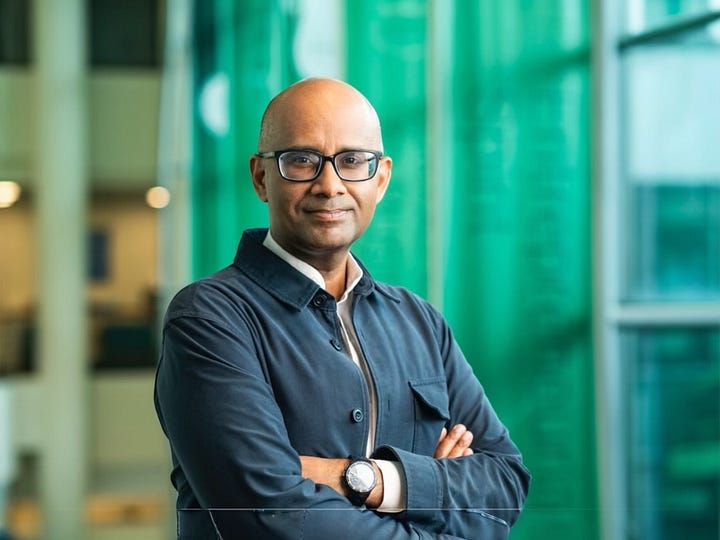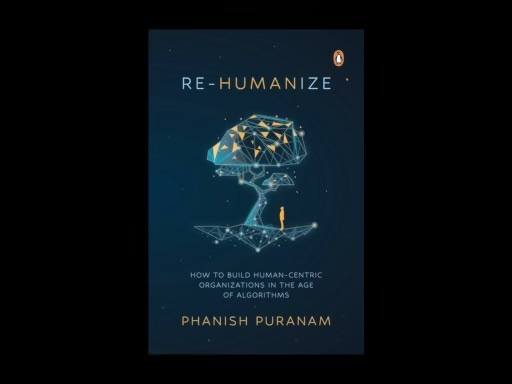Re-Humanizing a Bold Vision for Human-Centric Organizations


In an era where algorithms fuel decisions and efficiency often trumps human connection, Phanish Puranam’s Re-Humanize: How to Build Human-Centric Organizations in the Age of Algorithms arrives as a timely, necessary wake-up call.
A professor of strategy and organization design at INSEAD, Phanish challenges the prevailing narrative that the future of work belongs solely to machines. Instead, he makes a compelling case for integrating artificial intelligence in ways that amplify—not replace—human agency, creativity, and collaboration.
It’s here where Phanish’s arguments align closely with our core mission of the Dave Alexander Center for Social Capital which champions business strategies that prioritize people, relationships, and shared prosperity over short-term efficiency gains.
His work speaks directly to the future of social capital in business, where the true measure of success isn’t just how much work gets done, but how organizations foster meaning, trust, and human flourishing.
Beyond Efficiency: Reclaiming the Human Element in Business
The book centers on the tension between goal-centric and human-centric organizations. The former optimize for efficiency, often leveraging AI to automate decisions and streamline processes. While this can yield impressive results, it also risks sidelining employees, reducing their roles to mere executors of algorithmic outputs.
Human-centric organizations, by contrast, balance efficiency with meaning, ensuring that technology serves people rather than the other way around.
As AI and digitalization accelerate, Phanish argues that leaders must ensure that technology enhances rather than erodes human connection. This is particularly critical in industries where AI plays a pivotal role in decision-making, such as finance, healthcare, and entertainment.
In healthcare, for example, AI-driven diagnostics can improve accuracy and speed. But if hospitals prioritize automation over patient-doctor relationships, patients may feel like they’re engaging with a system rather than a caregiver. The key isn’t rejecting AI but integrating it in ways that empower professionals rather than replace them.
This insight resonates deeply with the work of the Dave Alexander Center for Social Capital, where we advocate for business models that see employees not as cost centers to be optimized but as the heart of sustainable success. Organizations that treat AI as a tool for enhancing human potential rather than eliminating human roles will not only attract top talent but also foster deeper innovation and long-term resilience.
The Coming Shift: Will AI Flatten or Reinforce Hierarchies?
One of the most thought-provoking sections of Re-Humanize explores the evolving structure of organizations. AI has the potential to decentralize decision-making, but the way it’s implemented will determine whether it leads to more control from the top or more autonomy for employees.
More Control from the Top: If AI is primarily used for surveillance, performance tracking, and automated decision-making, organizations may appear flatter but actually become more centralized. Leaders would hold even more control, with decisions dictated by data rather than human discretion.
More Power to Employees: If AI is designed to enhance collaboration, improve information-sharing, and facilitate autonomous problem-solving, it can truly distribute decision-making power. In this model, AI is a tool for self-organizing teams rather than top-down control.
Phanish challenges leaders to ask themselves which version of AI-driven organizations they want to build. If they care about both efficiency and human agency, they should prioritize AI that augments employees rather than simply monitoring them.
This shift, he argues, will redefine leadership—moving from micromanaging tasks to coaching, mentoring, and setting strategic direction.
At the Dave Alexander Center for Social Capital, we see this as an opportunity to redefine the role of leadership in the digital age. True leadership in an AI-driven world won’t be about overseeing routine work—it will be about inspiring teams, cultivating culture, and ensuring that technology serves human well-being rather than diminishing it.
AI as a Force for Meaning and Purpose
A core argument of Re-Humanize is that organizations should not just be about efficiency but also about shared purpose. If AI is only used to monitor, optimize, and enforce compliance, employees will inevitably feel disempowered and alienated.
But if AI is designed to support collaboration, foster virtual communities, and enhance learning, it can actually strengthen workplace culture rather than erode it.
Phanish highlights real-world examples of companies using AI in ways that enrich human work:
• Microsoft leverages AI-driven insights to help employees work more effectively without micromanagement. Their productivity tools optimize workflows while respecting privacy, reducing friction rather than replacing human connection.
• Salesforce uses AI to enhance collaboration among remote teams, ensuring that digital transformation strengthens rather than weakens human relationships.
• DBS Bank in Singapore equips employees with AI-powered tools rather than replacing them, demonstrating how AI can be a catalyst for continuous learning and job evolution rather than just automation.
At the Dave Alexander Center for Social Capital, we champion these kinds of forward-thinking, people-first approaches. Organizations that use AI to amplify trust, collaboration, and shared purpose will not only perform better but will also foster deeper commitment from employees and customers alike.
Building Trust Between Humans and AI
One of the greatest risks of AI-driven decision-making is loss of trust. Employees are unlikely to trust AI systems that simply replace them rather than support them. Phanish introduces the concept of “ensembling”—a collaborative model where AI and humans work together, rather than in isolation.
For example, in medicine, rather than letting AI make final diagnoses alone, doctors can use AI-generated insights as one input among many, comparing them against human expertise and experience. This model not only ensures better outcomes but also preserves critical human skills, keeping employees engaged rather than making them feel redundant.
The key takeaway? AI should be treated as a partner, not a replacement. The organizations that get this right will foster greater transparency, trust, and resilience, creating workplaces where humans and technology truly complement each other.
Rethinking Productivity in the AI Era
Historically, productivity has been measured in output and efficiency. But as AI takes over execution-focused tasks, Phanish argues that organizations should shift their focus toward creativity, problem-solving, and innovation.
• Execution = Getting things done efficiently. AI excels at this—handling logistics, data processing, and routine decision-making.
• Search = Exploring new ideas, solving novel problems, and driving innovation. This is where human creativity shines, and where the future of work will increasingly reside.
At the Dave Alexander Center for Social Capital, we see this as an opportunity to redefine success in the digital age. The most successful businesses won’t just be efficient—they’ll be hubs of creativity, innovation, and human connection.
Charting a New Vision for AI and Human Flourishing
Re-Humanize is more than just a business book—it’s a manifesto for a more thoughtful, human-centered future. Phanish makes a persuasive case that AI should empower rather than replace, augment rather than control, and strengthen rather than erode the human experience in organizations.
At the Dave Alexander Center for Social Capital, we believe this vision is not just possible—it is necessary. The businesses that thrive in the 21st century won’t be the ones that pursue efficiency at all costs but the ones that invest in relationships, trust, and social capital. AI is not the enemy of human connection—but only if we design it that way.
In the end, the future of business, and indeed the future of work, depends on our ability to re-humanize.




